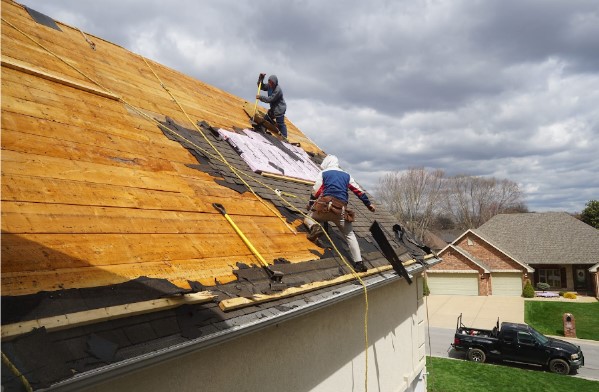Protecting Your Workforce: The Importance of Medical Insurance Coverage for Roofing Project Injuries

Roofing projects are demanding and potentially hazardous, requiring careful attention to safety and risk management. Ensuring that your workforce is adequately protected against injuries is not just a regulatory obligation but also a critical aspect of maintaining a healthy and productive team. One of the key components of this protection is comprehensive medical insurance coverage. This article explores the importance of medical insurance for roofing project injuries and highlights the role of workman’s compensation in safeguarding both workers and employers.
The Nature of Roofing Project Injuries
Roofing work involves significant physical exertion and exposure to various hazards, including heights, heavy materials, and adverse weather conditions. These factors contribute to a higher risk of injuries compared to other construction activities. Common injuries in roofing include falls, cuts, abrasions, and strains, all of which can lead to substantial medical costs and time away from work.
A well-structured medical insurance plan provides a safety net for workers who sustain injuries on the job. It ensures that they receive prompt medical attention and appropriate treatment, which is crucial for a speedy recovery and return to work. Furthermore, having medical insurance in place can mitigate the financial burden on workers and their families, thereby enhancing overall morale and job satisfaction.
The Role of Medical Insurance in Injury Management
Medical insurance coverage plays a pivotal role in managing roofing project injuries. It typically includes the following key benefits:
- Emergency Medical Care: Immediate access to emergency services is vital in the event of serious injuries. Medical insurance ensures that workers receive timely care, which can significantly impact their recovery and long-term health outcomes.
- Surgical and Hospitalization Costs: Roofing injuries may require surgery or extended hospital stays. Medical insurance helps cover these substantial expenses, relieving workers of the financial strain associated with such treatments.
- Rehabilitation Services: Post-injury rehabilitation is essential for workers to regain their full functionality. Medical insurance often covers physical therapy and other rehabilitation services, facilitating a quicker and more effective recovery.
- Long-Term Disability Coverage: In cases where injuries lead to long-term or permanent disabilities, medical insurance can provide disability benefits to support workers and their families financially.
Workman’s Compensation: A Crucial Component of Coverage
Workman’s Compensation is a critical aspect of medical insurance coverage for roofing projects. This specialized insurance is designed to address the unique needs of workers who are injured on the job. It provides several key benefits:
- Medical Expenses Coverage: Workman’s compensation covers medical expenses related to work-related injuries, including doctor visits, hospital stays, medications, and rehabilitation services. This ensures that injured workers receive the necessary treatment without incurring out-of-pocket costs.
- Lost Wages Replacement: Injuries can result in time away from work, leading to lost wages. Workman’s compensation provides wage replacement benefits to compensate for the income workers lose while they are recovering.
- Vocational Rehabilitation: For workers who may not be able to return to their previous job due to injury, workmans compensation offers vocational rehabilitation services. These services help injured workers acquire new skills or find alternative employment opportunities.
- Legal Protection: Workman’s compensation also offers legal protection for employers by limiting their liability for workplace injuries. This system reduces the risk of costly litigation and helps maintain a positive work environment.
Implementing Comprehensive Coverage in Roofing Projects
To effectively protect your workforce, it is essential to implement a comprehensive medical insurance and workman’s compensation plan. Here are some best practices:
- Choose a Reputable Insurance Provider: Partner with an insurance provider that has experience in the construction and roofing industry. They will be better equipped to understand the specific risks and needs associated with roofing projects.
- Regularly Review and Update Coverage: As roofing projects evolve and new risks emerge, regularly review and update your insurance coverage to ensure it remains adequate and relevant.
- Educate Your Workforce: Provide training and information to your workforce about the available insurance benefits and how to access them in the event of an injury. Awareness can enhance the effectiveness of your coverage and support system.
- Implement Safety Measures: While medical insurance and workman’s compensation are crucial, proactive safety measures can help prevent injuries from occurring in the first place. Invest in safety training, proper equipment, and regular safety audits to minimize risks.
Conclusion
Medical insurance coverage, including workman’s compensation, is indispensable for protecting your workforce in roofing projects. It ensures that injured workers receive the necessary medical care, financial support, and rehabilitation services to facilitate their recovery and return to work. By prioritizing comprehensive insurance coverage and implementing effective safety measures, you can safeguard your employees’ well-being and maintain a productive, resilient workforce. Investing in these protections not only complies with legal requirements but also demonstrates a commitment to the health and safety of your team, fostering a positive and supportive work environment.
